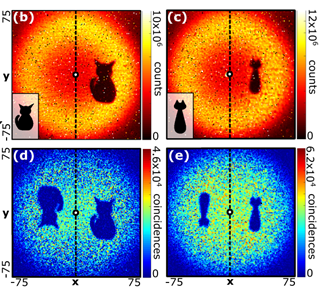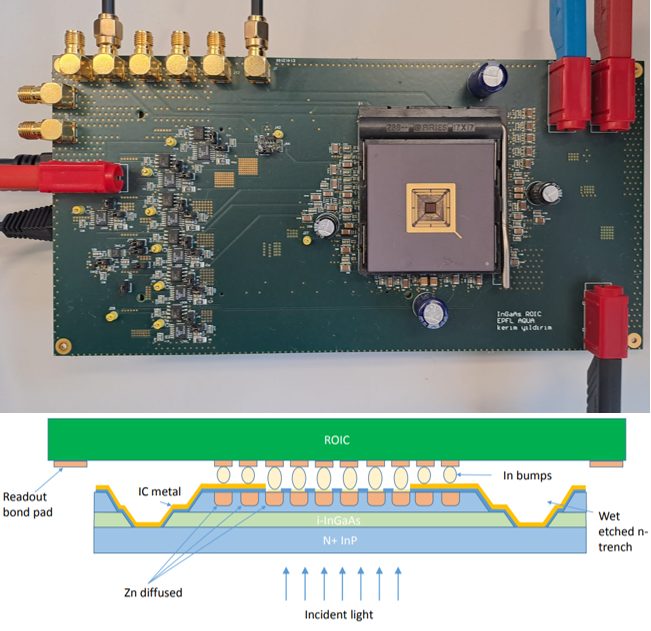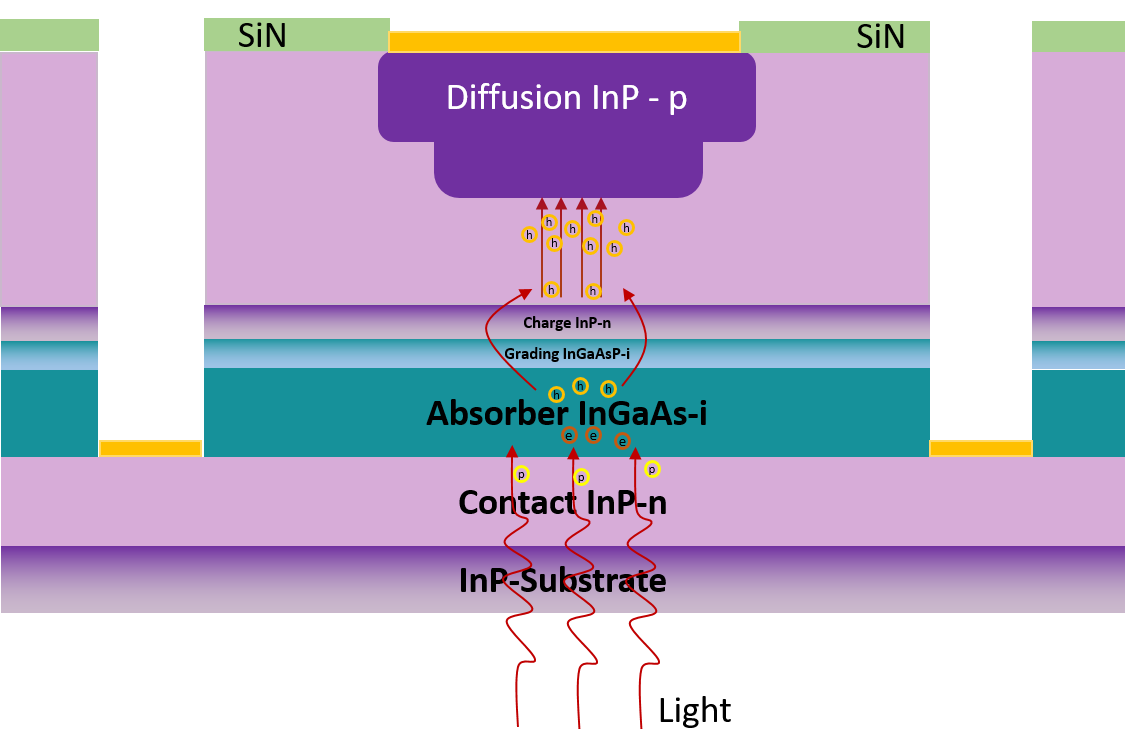Master projects
System development of a real-time quantum distillation imager

Description and contact info can be found here.
Contact: Paul Mos, [email protected]
Test of a Photo Diode for the Swiss Light Source 2.0

The Swiss Light Source SLS 2.0 at the Paul Scherrer Institut is a state-of-the-art synchrotron ring which will go into operation in 2025. We are aiming at the measurement of the length of the electron pulses in the storage ring, in order to understand the beam dynamics, and to maximize the beam lifetime.
To this goal, we want to characterize a photodiode with 50 GHz bandwidth. The photodiode is connected to an amplifier, which in turn feeds several bandpass filters. A relative measurement of the frequency content in the bands will allow us to infer the pulse length of the optical signal.
In a later stage, we are planning to install this diode in the accelerator facility, and couple synchrotron radiation into this diode. The output of the bandpass filters will then be digitized at baseband, with the 500 MHz repetition rate of the electron pulses.
Your tasks will be to set up this diode with a picosecond laser, to measure the instrument response function, and to assess the concept of measurements in different frequency bands to determine pulse length.
Your master’s thesis will be carried out working with a team of scientists and engineers at PSI and at EPFL. The work can be carried out at EPFL, or at PSI in Villigen.
If you are interested, please contact:
Rasmus Ischebeck, [email protected]
Edoardo Charbon, [email protected]
Characterization of Readout Integrated Circuits (ROIC) for InGaAs-based SPAD arrays

Single-photon sensitivity, picosecond temporal resolution and CMOS integration makes single-photon avalanche diode (SPAD) arrays desirable for 3D imaging applications including light detection and ranging (LiDAR), fluorescent lifetime imaging (FLIM), quantum key distribution (QKD) and positron emission tomography (PET). InGaAs/InP based SPADs are promising to be used in longer wavelengths for which silicon based SPADs are inefficient due to their higher bandgap. On the other hand, using InGaAs/InP detectors instead of CMOS integrated SPADs brings challenges including 3D integration and higher noise.
At AQUA lab we are developing a hybrid sensor which consists of a CMOS readout integrated circuit (ROIC) bonded to InGaAs/InP SPADs to be used for various 3D imaging applications. The project focuses on the setup of the testing environment of the ROIC which includes the printed circuit board (PCB) and FPGA coding. This will be followed by measurements with the 3D bonded sensor to characterize the SPAD array and imaging experiments. The project can be adapted as a semester project or a master’s thesis.
Tasks
- Literature review to understand the principles of SPADs and readout circuits.
- Design of a new PCB for the ROIC taking the previous one as a reference.
- FPGA firmware design using Verilog/VHDL to control the ROIC and test its functionality.
- SPAD array characterization, LiDAR/3D imaging measurements.
Type: Can be adapted for a semester or Masters project.
Location: Microcity Neuchatel
Contact: Halil Kerim Yildirim, [email protected]
RTL implementation for real time FLIM measurements
Description and contact info can be found here.
Contact: Paul Mos, [email protected]
Characterization of a TCSPC SPAD camera and measurement of diffusive mediums
Description and contact info can be found here
Contact: Paul Mos, [email protected]
Cryo-CMOS Design of Scalable SNSPD Front-end

Motivation
Single-photon detectors and nanoscale superconducting devices are two major candidates for realizing and supporting quantum technologies. Superconducting nanowires single-photon detectors (SNSPDs) in particular, cover various applications that evolved in the quantum field for the past few years such as high-rate and long-distance quantum key distribution, satellite laser ranging, long-distance imaging and non-quantum applications like molecular spectroscopy. However, the largest SNSPD array reported so far is the kilo-pixel array. One of the main constraints to achieve high levels of scaling in these detectors is the limited power budget available within the cooling system.
The architectures demonstrated so far, based mainly on analog implementations [1], [2], [3], are promising. However, going beyond one thousand pixels, while maintaining low jitter, low dark counts, high efficiency, and high-count rate is really challenging. For this reason, more innovation is required to scale up SNSPD arrays.
Description
The master project consists on the design and analysis of a low power readout circuit to interface SNSPDs. The project will consist of three main phases:
- Study and understanding of the physics behind Superconducting detectors. In the first months, Simulations using Cadence and SPICE will be conducted to deeply understand the main limitations from an analog design perspective.
- Design. The student will come up or contribute in building up new ideas for a single pixel readout.
- Testing. The student will help in the test of some building blocks at cryogenic temperatures as well as the realization of prototypes that may be patented.
Tasks
- Literature research.
- Detailed analysis of the SNSPD-pixel interface on Cadence.
- Electromagnetic analysis of the device using ADS.
- Design of prototypes on Altium.
- Cryogenic Analog and Digital interface testing.
[1] Emma E. Wollman et al., “Kilo pixel array of superconducting nanowire single-photon detectors,” Opt. Express 27, 35279-35289 (2019).
[2] Zhao et al. “Single-photon imager based on a superconducting nanowire delay line,” Nature Photon 11, 247–251 (2017).
[3] S. Doerner et al., “Frequency-multiplexed bias and readout of a 16-pixel superconducting nanowire single photon detector array,” Appl. Phys. Lett. 111(3), 032603 (2017).
Supervisor: Jad Benserhir, Prof. Edoardo Charbon
Location: EPFL in Microcity, Neuchâtel
Starting date: TBD
Contact: Jad Benserhir [email protected]
Fabrication of InGaAs/InP based single photon avalanche detectors optimized for high efficiency at near infrared

The goal of the project is to demonstrate efficiency improvement at wavelengths below 900 nm by comparing the single photon efficiency spectrum of two InGaAs/InP SPADs with and without substrate. For this purpose student should fabricate these devices in CMi (Center of Micronanotechnology) by following various photolithography, etching, metallization and thinning processes. Following the fabrication, devices should be placed on a PCB and characterized for their photon detection efficiency. The student will have a chance to experience/perform all of the fabrication process of a single photon avalanche detector from scratch and set up an experiment to analyze the performance of the detector.
This project can be adapted as a semester or Master project.
Contact: Ekin Kizilkan, [email protected]
Quantum Vision for Extreme Robotics
Projects description and contact info can be found here.
Contact: David Rodríguez Martínez, [email protected]
Semester projects
Fabrication of InGaAs/InP based single photon avalanche detectors optimized for high efficiency at near infrared

The goal of the project is to demonstrate efficiency improvement at wavelengths below 900 nm by comparing the single photon efficiency spectrum of two InGaAs/InP SPADs with and without substrate. For this purpose student should fabricate these devices in CMi (Center of Micronanotechnology) by following various photolithography, etching, metallization and thinning processes. Following the fabrication, devices should be placed on a PCB and characterized for their photon detection efficiency. The student will have a chance to experience/perform all of the fabrication process of a single photon avalanche detector from scratch and set up an experiment to analyze the performance of the detector.
This project can be adapted as a semester or Master project.
Contact: Ekin Kizilkan, [email protected]